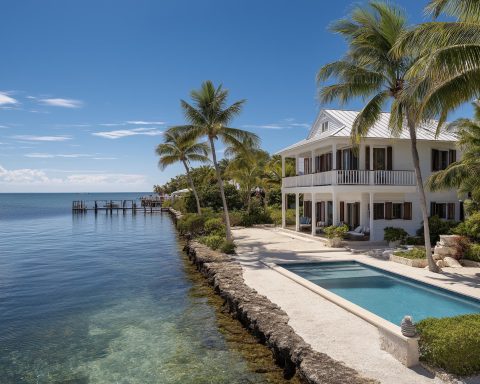Key Highlights:
- U.S. interest rates turn downward: The Federal Reserve’s first rate cut of 2025 (a 0.25% trim) signaled a shift to easier money, nudging 30-year mortgage rates to ~6.3% – the lowest in almost a year reuters.com bankrate.com. Cheaper mortgages are stirring cautious optimism among American homebuyers and builders.
- Housing markets start to tilt to buyers: After years of seller dominance, the U.S. housing market is “finally starting to listen” to frustrated buyers. Inventory is up, homes sit longer (median ~60 days), and over 20% of listings had price cuts in recent months ustitlerecords.com ustitlerecords.com. While not a full buyer’s market, power is slowly rebalancing as high prices and rates force sellers to adjust.
- Big moves in real estate finance: Blackstone named insider Katie Keenan as CEO of its $100+ billion real estate income trust (BREIT) after the prior head was tragically killed in a July office shooting reuters.com. “BREIT is incredibly well-positioned and I am looking forward to…capitalize on the ongoing real estate recovery,” Keenan said optimistically reuters.com. In the Middle East, private equity giants Permira and Blackstone also invested $525 million for a stake in Dubai’s Property Finder platform, betting on the Gulf’s red-hot property market marketsgroup.org.
- Europe’s mixed real estate revival: Europe saw glimmers of a rebound. German home prices are forecast to rise ~3% in 2025 after a two-year slump reuters.com, as the European Central Bank’s rate cuts (totaling 200 bps this cycle) gradually filter through. Eurozone mortgage rates have eased to ~3.3% (Q2) realestate.bnpparibas.com, lifting demand. However, affordability remains tight and new home construction is way down (permits fell 19% in H1) amid developer caution realestate.bnpparibas.com realestate.bnpparibas.com. Meanwhile, European commercial property values have inched up four quarters in a row europeanbusinessmagazine.com, hinting at stabilization even as offices and retail assets stay under pressure.
- Asia-Pacific under strain: China’s property crisis grinds on – a Reuters poll sees new-home prices falling ~3.8% in 2025 (not as steep as feared, but still a decline) reuters.com. Years of developer deleveraging have triggered waves of defaults, stalled projects, and slumping sales reuters.com. Policy support (lower down-payments, mortgage rate cuts, programs for unsold homes) has so far only blunted the downturn, not ended it. Analysts warn structural challenges – from demographic shifts to high unsold inventory – will hamper any quick recovery reuters.com. In Hong Kong, the government moved to prop up its luxury housing segment by slashing its investor visa property threshold from HK$50 million to HK$30 million imidaily.com. The change expands the pool of eligible high-end buyers, but local experts remain skeptical. “The [Hong Kong] market is in the doldrums,” says Stephen Barnes, a residency consultant, calling the tweak mere “tinkering at the edges” of a much bigger affordability problem.
- Middle East real estate roaring: Gulf property markets continued to surge. Dubai’s real estate values have ballooned ~70% over the past four years amid an influx of foreign investors and visa reforms marketsgroup.org. While analysts at Fitch Ratings foresee a possible cooldown (even double-digit price drops) by late 2025 marketsgroup.org, for now the boom persists. This week saw global investors doubling down on Dubai: Permira and Blackstone’s $525 million bet on Property Finder will help the online portal expand across MENA marketsgroup.org marketsgroup.org. Elsewhere in the region, Qatar reported a 18.5% weekly jump in real estate sales in early September, reflecting vigorous demand for everything from land plots to villas arabnews.com arabnews.com. Overall, the Middle East’s mix of high oil-driven liquidity and pro-growth policies is keeping real estate activity buoyant – even as higher interest rates globally start to cast a shadow.
- Emerging markets diverge: Latin America’s real estate outlook is split. Brazil is grappling with sky-high borrowing costs – its central bank just held the benchmark rate at a punishing 15% to tame inflation reuters.com. The credit squeeze has dampened homebuying severely. In contrast, parts of Latin America are poised for a rebound as rates ease: in Chile, after a 13% plunge in home sales last year, a 5–10% sales uptick is expected in 2025 thanks to improving mortgage access and declining interest rates adventuresincre.com. Analysts note Chile’s property market is showing early recovery signs, though broader investment remains subdued. Across Africa, investor interest in real estate is on the rise. Industry leaders met in mid-September at major property summits in Lagos and Cape Town, eyeing opportunities in fast-growing cities. The continent’s real estate sector is projected to expand robustly – from an estimated $17.6 trillion in 2025 to $21.9 trillion by 2029 in value eyeofriyadh.com – underpinned by urbanization and rising demand for housing and commercial space. Still, challenges from financing to infrastructure continue to restrain Africa’s full potential.
North America: Rate Relief and Housing Hints of a Turn
United States – Rates cut as housing adjusts: In a milestone policy shift, the U.S. Federal Reserve cut interest rates by 25 basis points this week – its first rate reduction since 2024 reuters.com. The move, while modest, marks the start of an expected easing cycle aimed at supporting a cooling economy. For real estate, the immediate impact is slightly cheaper mortgages: average 30-year fixed mortgage rates dipped to ~6.30%, the lowest level in nearly a year bankrate.com. Analysts caution that home loan rates won’t “tumble overnight” with one Fed cut reuters.com, but the direction is welcome news for homebuyers long pinched by 7%+ rates. Mortgage applications have already ticked up in response to the recent gradual rate declines, signaling pent-up demand. Homebuilder stocks also rallied on the Fed news, since lower financing costs could “give a jolt” to new housing development, according to one real estate broker foxbusiness.com.
On the ground, the American housing market is showing signs of shifting toward a more balanced dynamic. Supply has been slowly improving – new listings and construction are up from pandemic lows – and buyer fatigue is forcing sellers to get realistic. Homes now spend a median of about 60 days on the market, above pre-pandemic norms for the second straight month ustitlerecords.com. Price cuts have become common: over 20% of U.S. listings in August had a price reduction ustitlerecords.com as sellers adjust expectations. “For prospective buyers who have been waiting on the sidelines, the housing market is finally starting to listen,” one economist observed, noting that years of soaring prices and 7%+ mortgage rates had largely shut out first-time buyers ustitlerecords.com. While it’s not yet a buyer’s market nationally – home prices are still up in many regions – the negotiating power is gradually tilting away from sellers. Affordability remains the big hurdle, however. Even at 6.3%, mortgage rates are roughly double pre-2022 levels, and prices haven’t fallen enough in most cities to compensate. Economists say a meaningful improvement in affordability will require “further drops in mortgage rates and much slower home price growth, or even declines” in prices bankrate.com. The Fed’s newfound dovishness is a start, but buyers and sellers are still feeling out where the new equilibrium lies in 2025.
Commercial & investment news: In commercial real estate, the U.S. sector continues to grapple with high office vacancies and refinancing risks, but there were notable corporate developments. Blackstone, the world’s largest alternative asset manager, made headlines by appointing a new chief executive for its flagship real estate fund (the non-traded Blackstone Real Estate Income Trust). The firm tapped Katie Keenan – a decade-long company veteran – as BREIT’s CEO and global head of Core+ real estate, after the fatal shooting of her predecessor, Wesley LePatner, in July reuters.com. (LePatner was one of four people killed by a gunman in Blackstone’s New York lobby; police said the attack was not specifically targeted at the firm.) BREIT, with over $100 billion in assets, is one of the world’s largest real estate investment trusts. The fund had faced heavy redemption requests late last year, but Blackstone stabilized it and continued to project confidence. Keenan noted that “BREIT is incredibly well-positioned” to capitalize on an ongoing recovery in real estate markets reuters.com. The leadership change underscores both the challenges and resilience in commercial real estate: even as property investors navigate interest rate pressures and uneven demand (especially for offices), major players like Blackstone are repositioning for future growth in sectors like rental housing, industrial parks, and data centers that have shown strength.
Canada – Tackling the affordability crisis: In Canada, housing affordability (or the lack thereof) is front-page news, and the government used this week to launch a bold new initiative. On Sept 19, Ottawa announced “Build Canada Homes”, a new federal housing development agency aimed at supercharging home construction canada.ca. With a mandate to build and finance affordable housing at scale, Build Canada Homes will serve as a one-stop developer, partnering with private builders and local governments to deliver homes faster. To kick-start the effort, the federal housing minister rolled out a C$1.5 billion loan top-up for the national Affordable Housing Fund’s construction program canada.ca. This infusion – alongside an accelerated release of C$385 million earmarked for rapid housing – is expected to fund thousands of new affordable units and “prioritize shovel-ready projects” that can begin immediately canada.ca. The broader goal is to double the pace of housing construction over the next decade to catch up with Canada’s surging demand canada.ca. Experts have pointed to Canada’s record immigration and chronically low housing supply as drivers of an acute affordability problem. In major cities like Toronto and Vancouver, average home prices remain out of reach for many locals, and rents have hit record highs. The new agency represents a significant policy pivot – effectively, the federal government stepping directly into the housing market to boost supply. “We’re not just building homes – we’re catalyzing the growth of the housing industry,” Housing Minister Gregor Robertson said, calling the plan a “turning point” in how Canada delivers affordable housing canada.ca. The initiative was met with cautious optimism: developers welcome the financing support, though some note that labor shortages and high material costs could still be bottlenecks. Nonetheless, this marks one of Canada’s most aggressive interventions in housing, as the country seeks to ease a housing crunch that’s been years in the making.
Europe: Easing Rates, Early Rebound Signs – and Persistent Challenges
Housing markets – a patchy recovery: Europe’s real estate picture in late 2025 is one of cautious optimism amid lingering pains. With inflation finally cooling, the European Central Bank has halted its rate hikes and even delivered some modest cuts, totaling about 2 percentage points of easing over recent quarters reuters.com. The effects are slowly trickling down to borrowers. In most European countries, mortgage rates have fallen from their 2022 peaks – the average euro-area home loan rate is about 3.3% as of Q2 2025, down significantly thanks to monetary easing realestate.bnpparibas.com. Lower financing costs are helping stabilize housing demand. According to new data, house prices across major European cities rose 5.5% year-on-year in Q1 2025 realestate.bnpparibas.com, a notable uptick after many markets saw price drops or stagnation last year. For example, Germany, the continent’s largest economy, appears to be emerging from its worst property slump in decades. A Reuters poll of experts predicts German home prices will rise ~3% in 2025, the first annual increase in three years reuters.com. This comes after prices in Germany corrected by about 8% in 2023 amid a sharp jump in interest rates. Now, with the ECB’s reversal and resilient employment, Germany’s housing downturn is bottoming out. “The recovery in the housing market continues, despite stagnating affordability,” said Carsten Brzeski, ING’s head of macroeconomics, noting that while confidence is returning, high uncertainty and economic risks still weigh on buyers reuters.com.
Elsewhere in Europe, France and Spain are also seeing glimmers of growth in real estate activity as credit conditions improve. Even the UK, which faced a steep correction in 2023, has seen a recent leveling off in prices – though rising unemployment and a mini recession there keep the outlook guarded. A big caveat across Europe is affordability. Even with somewhat lower mortgage rates, borrowing costs remain well above pre-2022 levels. Meanwhile, home prices have not fallen enough in many cities to restore affordability for first-time buyers. In fact, Europe’s housing affordability index remains near multi-decade lows, and household purchasing power for housing is expected to stay weak in most cities realestate.bnpparibas.com. This is because any benefit from lower rates is being offset by still-rising property prices in some markets. For instance, in parts of Central Europe and the Nordics, house prices are climbing again as demand outstrips supply. Renters are also feeling the squeeze: European rents have hit record highs in many capitals realestate.bnpparibas.com, fueled by would-be buyers staying in the rental market, a shortage of new construction, and in some cases the popularity of short-term tourist rentals. Cities from Dublin to Madrid report strong rental demand despite already high rents, underscoring the depth of Europe’s housing shortage.
Crucially, new housing supply in Europe is faltering. Developers across the EU have pulled back due to the earlier spike in interest rates, higher construction costs, and economic uncertainty. In the first half of 2025, European building permits for new housing fell ~19% year-on-year realestate.bnpparibas.com – a steep drop that signals fewer homes will be built in 2025–2026. Developer confidence has been dented by what one industry report called the “legacy of high inflation [and] high interest rates”, plus challenges like stricter permitting rules in some countries realestate.bnpparibas.com. If this construction shortfall continues, it could worsen the supply-demand imbalance once the economy picks up. Governments in Germany, the Netherlands, and elsewhere are contemplating stimulus measures (such as subsidies or zoning reforms) to revive homebuilding. Rent control policies in some cities are also a double-edged sword: while protecting tenants, they can discourage investment in new rental housing. All told, Europe’s residential sector is entering 2025 on slightly firmer footing than a year ago, thanks to monetary loosening, but it’s not out of the woods. Affordability and supply remain pressing issues, and any economic shock (or a return of inflation) could quickly derail the fragile recovery.
Commercial sector – stabilizing, but not booming: Europe’s commercial real estate sector, hammered by rising yields and falling valuations in 2022–23, is showing tentative signs of stabilization. According to data from Altus Group, European commercial property values have now risen for four consecutive quarters europeanbusinessmagazine.com, marking a slow recovery in asset prices. This “upward trend” suggests market fundamentals are gradually regaining balance despite patchy economic conditions europeanbusinessmagazine.com. Investor sentiment has improved in segments like logistics warehouses and multifamily rental blocks, which are seen as resilient. Cross-border investment flows into Europe have also picked up modestly in 2025, after a very weak 2024.
That said, the recovery is very uneven across property types. Office buildings remain the most stressed segment. The remote-work shift continues to dampen office demand, pushing vacancy rates to decade highs in some big cities. For example, central London offices are now flirting with 9–10% vacancy, and values are ~25% below their peak by some estimates. Retail real estate is similarly challenged by e-commerce and changing consumer habits, with weaker rental demand and rising costs hitting shopping centers and high streets directorstalkinterviews.com. “More challenged segments, offices and retail, remain under stress,” notes a European property outlook, highlighting “weaker rental demand [and] rising costs” in these sectors directorstalkinterviews.com. In contrast, industrial and logistics properties – like distribution centers – are holding value much better, thanks to the continued growth of online shopping and supply-chain reconfigurations post-pandemic. Hotel and hospitality real estate in major tourist destinations has also rebounded strongly in 2023–25 as travel roared back.
Investor strategies are evolving: there’s increased interest in redeveloping underused office buildings into apartments or mixed-use spaces, a trend encouraged by policymakers to address housing shortages. The financing environment, while improved from a year ago, is still cautious – banks have tightened lending standards, and only the best-capitalized projects are securing loans at reasonable rates. Refinancing is a looming issue for many property owners who took on cheap debt a few years ago; as loans come due, some may face distress or fire-sales if they can’t refinance affordably. So far, Europe has not seen a wave of forced sales, and the gradual fall in interest rates may avert a worst-case scenario. In summary, Europe’s commercial real estate market is finding its footing after a rough patch. Stabilizing yields and slightly improving economic sentiment have lifted values marginally over the past year europeanbusinessmagazine.com. But the sector’s health is bifurcated – with modern logistics, residential and prime assets performing well, while older offices and retail sites struggle. The next phase will depend on the economy (does Europe dodge a recession?) and on how occupier demand evolves in this post-COVID, higher-cost world.
Asia-Pacific: China’s Property Woes and Policy Moves in Focus
China – Crisis persists despite support: All eyes remain on China’s real estate crisis, which continues to cast a long shadow over the world’s second-largest economy. New data and forecasts out this month confirm that China’s property downturn is far from over, though there are hints the decline is moderating. A Reuters quarterly poll of economists found that new home prices in China are expected to fall 3.8% in 2025 reuters.com – a significant drop, but a slightly smaller decline than previously feared (an improvement from a 4.8% drop forecast in May). Prices may finally stabilize by 2027, returning to a modest growth path then reuters.com. For 2026, another 0.5% dip is projected before a turnaround. This protracted slump follows the bursting of China’s real estate bubble and Beijing’s crackdown on excessive developer debt that began a few years ago. The sector’s troubles were laid bare by a “deleveraging campaign” that exposed huge liabilities on developers’ balance sheets reuters.com, leading to a liquidity crunch. As a result, a wave of developer defaults and bankruptcies has been sweeping the industry reuters.com. Evergrande – once China’s top developer – remains in restructuring, and peers like Country Garden have teetered on default as well. Construction of many pre-sold apartments has stalled, undermining consumer confidence. Property sales and investment are both forecast to drop further in 2025 (analysts predict a 7.5% fall in sales, worse than earlier estimates) reuters.com, showing the demand side is still very weak.
Beijing has responded over the past months with a flurry of support measures to try to stop the skid. Authorities cut mortgage rates and down-payment requirements for first-time homebuyers. Banks eased some lending rules and offered extensions to troubled developers. Local governments rolled out dozens of localized policies – from subsidies to looser homebuying restrictions – particularly in big cities. There are even programs to purchase unsold housing inventory and convert empty units to social housing reuters.com. These steps have provided some cushion: the decline in home prices is not as steep as initially feared, and buyer sentiment in top-tier cities improved slightly after mortgage rules were relaxed. However, the overall impact has been limited. New housing starts and land sales (a key revenue source for cities) remain deeply depressed. One major issue is that weak income growth and high youth unemployment in China are keeping many potential buyers on the sidelines reuters.com. Additionally, oversupply plagues smaller cities – many have huge inventories of unsold homes, a legacy of the construction boom. “The property sector will continue to face many structural challenges in the medium term, including demographic shifts, low housing affordability and high unsold inventory,” said Lulu Shi, an analyst at Fitch Ratings reuters.com. Most experts now think China’s housing market may not truly stabilize until late 2026 or 2027 reuters.com, and even then only with more aggressive intervention. There are growing calls for Beijing to take more direct action – such as using state funds to buy up excess housing or bail out key developers – to stop the downward spiral. As one Chinese credit analyst put it, incremental easing hasn’t been enough; “stabilizing the market may require…direct intervention by the central government,” possibly including government purchases of unsold homes and land to reduce the glut reuters.com. For now, China’s real estate downturn remains the biggest drag on its economy, restraining consumer spending and local government finances. The ripple effects are being felt globally too (e.g. lower Chinese demand for commodities and furniture). The coming months will test whether the recent support measures can gain traction or whether Beijing will escalate its rescue efforts to prevent a deeper housing bust.
Japan – BOJ holds steady, hints of change: In Japan, the central bank grabbed some headlines as it wrapped up a policy meeting on Sept 19. The Bank of Japan kept its ultra-low interest rates unchanged – holding the short-term rate at -0.1% and guiding 10-year bond yields around 0% – but it surprised markets with a small hawkish twist. The BOJ announced it will begin selling off some of its massive holdings of exchange-traded funds (ETFs), including real estate investment trusts (J-REITs) lazardassetmanagement.com. This is a notable shift for a bank that has been a huge buyer of assets for years as part of its stimulus. The decision to unload risk assets suggests the BOJ is cautiously preparing for an eventual exit from ultra-easy policy. For Japan’s real estate market, BOJ policy remaining accommodative is a continued boon – mortgage rates are very low, and property financing is cheap. Japan’s housing prices have been on a gentle upward trend, and commercial real estate (especially in Tokyo) has attracted heavy investment due to those cheap financing conditions. The BOJ’s slow pivot will be closely watched: any hint of raising rates in the future could reverberate through J-REIT prices and lending rates. For now, though, Japan’s property sector enjoys some of the lowest interest costs in the world, and the central bank’s careful approach suggests no abrupt changes. The BOJ’s ETF sales are expected to be gradual and shouldn’t disrupt markets significantly, but they signal an inflection point in a decades-long easing stance.
Hong Kong & SE Asia – Policy tweaks and market responses: In Hong Kong, policymakers took action this week to attract wealthy investors back to its softening property market. Chief Executive John Lee announced an easing of the Investment Entrant Scheme’s real estate rules: the minimum amount that investor migrants must put into residential property was cut from HK$50 million to HK$30 million imidaily.com. At the same time, the cap on investment in non-residential real estate (such as offices or shops) that counts toward the visa was raised from HK$10 million to HK$15 million imidaily.com. These changes aim to “broaden the pool of luxury residential stock” eligible for investment by affluent individuals, potentially unlocking new demand in the HK$30–50 million price bracket imidaily.com. Hong Kong relaunched this Capital Investment Entrant Scheme (CIES) in 2024 to bring in capital and boost markets; since then it has already received 1,900 applications representing HK$58 billion in pledged investments imidaily.com. By lowering the property threshold, officials hope more of that money flows into high-end flats, supporting prices in that segment.
Market observers, however, are not convinced this will move the needle much for Hong Kong’s broader real estate malaise. The city’s housing transactions have improved modestly in 2025 – August sales were up ~45% from a year earlier imidaily.com – and S&P forecasts 2025 could be the best year for HK housing since 2019 imidaily.com. But volumes are rebounding from historically low levels. “The real estate market [is] in the doldrums,” says Stephen Barnes of the Hong Kong Visa Centre, who argues the government is “tinkering at the edges” by adjusting the visa scheme without addressing fundamental demand drivers. Indeed, the mass-market and mid-tier housing segments – which most locals rely on – remain sluggish. Rising interest rates (Hong Kong rates track U.S. rate hikes) have hit affordability, and the population has only just begun growing again after pandemic emigration. The investor visa tweak will mainly affect a small slice of luxury properties, and even there, the number of transactions in the HK$30–50M range is relatively limited imidaily.com. So while Hong Kong’s elite property market might see a brief bump from a few extra buyers, the overall housing landscape is still waiting for a stronger catalyst (such as significant rate relief or economic revival) to truly turn around.
Elsewhere in Asia, real estate news is a mix of resilience and caution. Singapore and South Korea have kept property cooling measures in place to tame speculation, even as prices have stayed firm. Australia’s housing market, which dipped in 2022, has been climbing again through 2025 – helped by the Reserve Bank of Australia’s rate cuts earlier in the year and persistent undersupply in cities like Sydney. In fact, Australian home values have risen for six consecutive months through July propertyupdate.com.au, and some forecasts see prices hitting new highs in 2025. However, Australian policymakers are warning about housing affordability and climate risks (with homes in high-flood-risk areas still fetching rising prices despite potential future costs propertymarkets.news). India continues to see robust real estate demand, with the office and industrial segments particularly booming thanks to multinational corporate expansions and a manufacturing push. And in Southeast Asia, countries like Indonesia and Vietnam are attracting property investment as supply-chain shifts bring in new businesses; their residential markets have cooled slightly this year, but longer-term urbanization trends remain intact. In summary, Asia-Pacific’s real estate story this week is one of targeted interventions (rate cuts, visa tweaks) amid broader headwinds. The Chinese property slump is the major drag on the region, while other markets are managing a more balanced glide-path or modest growth thanks to careful policy management and enduring demand fundamentals.
Middle East: Booming Gulf Markets and Major Investments
The Middle East real estate sector has been a global bright spot in 2025, and this week underscored why. The oil-rich Gulf states in particular are experiencing a property upswing that contrasts sharply with the cooling markets in the West and China. Dubai remains at the epicenter of this boom. Property prices in Dubai have surged nearly 70% over the last four years marketsgroup.org, fueled by an influx of foreign buyers, high-net-worth individuals relocating for favorable taxes, and government “golden visa” programs that encourage real estate investment. The city has seen record sales of luxury villas and condos, and its skyline continues to evolve with mega-projects. However, there are notes of caution creeping in: Fitch Ratings recently projected that Dubai’s housing market could lose steam and even see double-digit price declines by late 2025 as more supply comes on line and global financial conditions tighten marketsgroup.org. For now though, momentum is strong, and this was evidenced by a headline-grabbing deal in the proptech space. Permira (a European private equity firm) and Blackstone (US investment giant) announced a $525 million investment for a minority stake in Property Finder, Dubai’s leading real estate classifieds portal marketsgroup.org. The deal, one of the largest VC-style investments in the region, values Property Finder highly and provides a partial exit to earlier investor General Atlantic marketsgroup.org. It also marks Permira’s first foray into the Middle East – notably, the firm just opened a Dubai office, underlining global investors’ interest in the region. Property Finder’s platform is akin to a Middle Eastern Zillow, and it has expanded into Saudi Arabia, Egypt, and Turkey. With the new funding, it aims to accelerate growth across MENA. The bet by Blackstone and Permira is a strong vote of confidence in the Gulf’s real estate demand and the digitization of its property markets. As one industry observer put it, this shows “sustained investor interest in the emirate’s real estate market” and the broader region marketsgroup.org.
Gulf region dynamism: Across the Gulf Cooperation Council (GCC) countries, real estate activity is robust. In Qatar, government data for early September showed a notable spike in transactions: 394 million Qatari riyals (~$108 million) in property sales in just one week (Aug 31–Sept 4) arabnews.com, an 18.5% jump over the previous week. These deals spanned vacant land, houses, residential towers, and commercial buildings arabnews.com, indicating broad-based demand from both end-users and investors. Qatar’s market got a boost from the 2022 FIFA World Cup and remains dynamic as the country diversifies its economy. Saudi Arabia is another hotspot – massive projects like NEOM (the futuristic $500 billion city) and The Red Sea resort development are underway, and Riyadh’s drive to become a global business hub has led to a construction boom in commercial real estate. The Saudi government’s recent move to allow full foreign ownership of real estate in parts of Riyadh and other cities is expected to spur investment. Abu Dhabi and Dubai continue to benefit from being seen as safe havens in a volatile world, attracting capital from Russia, China, and other regions. In Dubai, 2023 was a record year for property sales volume, and 2025 is on track to stay elevated. The rental market in Dubai and Abu Dhabi is also very strong, with rents up sharply as populations grow and fewer residents leave (in contrast to the expatriate exodus seen during the 2014–2018 oil downturn).
The Middle East’s real estate strength isn’t limited to residential; commercial and hospitality segments are thriving too. High oil revenues in the past two years have funded new shopping malls, office complexes, and logistics centers. For example, Riyadh is seeing a wave of new Grade A office supply to meet demand as multinational companies set up regional HQs (encouraged by Saudi’s policy mandating regional HQ presence for government contracts). Tourism-related real estate is booming in Saudi Arabia and UAE, with dozens of new hotels and resorts announced to capture growing visitor numbers. Even lesser-known markets like Oman and Bahrain have picked up – Oman is marketing luxury integrated tourism complexes to foreign buyers, and Bahrain has seen a rebound in retail and residential projects after some years of slow growth. A wildcard in the region is the Israel-Gaza situation which escalated in late 2025; while not directly a real estate story, it could have ripple effects on investor sentiment in the broader Middle East if geopolitical risk intensifies. (Notably, a controversial statement by Israel’s far-right finance minister calling Gaza a potential real estate “bonanza” if Hamas were defeated drew regional ire egyptindependent.com – underscoring how entwined real estate ambitions can be with politics in this region.)
Overall, the Middle East enters late 2025 as a magnet for real estate capital. Global investors are actively allocating funds to the region – whether through direct property purchases or via investments in property tech and funds – drawn by strong economic growth, relative currency stability (many Gulf currencies are pegged to the dollar), and pro-development government agendas. The key risk ahead is if oil prices drop or if higher global interest rates eventually cool off the market. For now, though, the Gulf real estate party continues, making it a standout performer on the world stage.
Africa & Latin America: Pockets of Growth amid Economic Hurdles
Africa – Rising investor interest in a growing market: Across Africa, real estate is increasingly viewed as a frontier of growth – with rapid urbanization, a young population, and expanding economies creating demand for everything from housing to office space and retail centers. This week, industry attention turned to two major gatherings: the Africa Property Investment Summit in Cape Town (Sept 18–19) and the African Real Estate Society conference in Lagos (Sept 9–12). These events drew developers, investors, and policymakers from across the continent, highlighting both the opportunities and challenges in African real estate. A striking projection making the rounds: Africa’s real estate sector is poised to grow from an estimated $17.64 trillion in 2025 to $21.92 trillion by 2029 in value eyeofriyadh.com. While such figures are estimates (and include the cumulative value of all property), they underscore the robust expansion anticipated as Africa’s economies develop. Sectors like hospitality are also on the upswing – Africa’s tourism and hotel market is expected to reach $730 billion by 2032 eyeofriyadh.com, creating a construction boom for resorts and business hotels.
On the ground, Nigeria, Kenya, South Africa, Egypt, and Morocco are among the leading markets seeing significant real estate projects. For instance, Nigeria has multiple new city projects (Eko Atlantic in Lagos, Centenary City in Abuja) and a burgeoning fintech sector driving demand for office and residential space. However, African markets also face headwinds: high interest rates in countries like Nigeria and Ghana have made financing construction costly, and currency volatility can deter foreign investors. A recent positive sign came as Nigeria’s inflation has started to retreat from multi-decade highs, allowing its central bank to pause rate hikes nigeriahousingmarket.com. Stakeholders are cautiously hopeful that lower inflation and more stable currencies in the coming years will unlock more real estate investment. There’s also innovation afoot – for example, a new proptech platform in Nigeria announced it will let people invest in fractional ownership of properties (in Nigeria and even abroad) for as little as $10 africa.businessinsider.com, aiming to democratize property investment. Such trends, along with an emphasis on green buildings and sustainable development (the theme of some summit panels), show how Africa’s real estate sector is maturing.
Still, the challenges remain stark. A key issue raised at the Lagos conference was data transparency: inadequate data on property prices and land titles is “threatening real estate growth” by making investors wary punchng.com. Many African countries lack comprehensive property registries, complicating transactions and financing. Additionally, housing affordability is a critical issue – while luxury malls and offices rise, many cities face housing deficits for middle and low-income residents. Governments from Ghana to Rwanda have launched affordable housing programs, but funding and execution sometimes fall short. Political instability and security concerns in certain regions also impact investor confidence. Despite these hurdles, the tone at recent events was forward-looking. There’s a sense that African real estate is at an inflection point: local developers are gaining experience, international partnerships are forming, and large pools of capital (from global institutions, diaspora investors, and sovereign wealth funds) are circling. In summary, Africa’s real estate market in late 2025 is characterized by optimism tempered with realism – growth is accelerating and the world is noticing, yet solving structural issues (finance, governance, infrastructure) will be key to sustaining the momentum.
Latin America – High rates vs. hopes of recovery: Latin America’s property markets presented a mixed picture this week, reflective of the region’s economic diversity. Brazil, the largest economy, exemplifies the challenges. In mid-September, Brazil’s central bank held its Selic interest rate at a towering 15% reuters.com – this is the second straight meeting at that level, after an aggressive 450 basis-point hiking cycle from 2024 to mid-2025 to combat inflation reuters.com. Such high rates have made borrowing exorbitantly expensive, dampening real estate activity. Mortgage lending in Brazil has slowed to a crawl, and both residential and commercial property sales are subdued as buyers and developers await rate relief. Brazil’s housing market had already been cooling; adjusted for inflation, home prices in Rio de Janeiro were slightly down year-on-year as of April 2025 globalpropertyguide.com. The central bank’s stance indicates it prioritizes anchoring inflation (still ~5% annually, above target) over stimulating growth. However, some analysts think Brazil is at or near the peak of its rate cycle – with inflation easing, a few foresee the start of rate cuts by year-end or early 2026 reuters.com. When that turn comes, it could breathe life back into mortgages and development. Until then, Brazil’s real estate sector faces a “challenging scenario, marked by high interest rates, inflationary pressures and fiscal uncertainties,” as one industry report noted practiceguides.chambers.com. The tough financing climate has led to stagnant construction and weaker demand, even though there is pent-up need for housing (Brazil has a large housing deficit). Some positive news: Brazil’s inflation did show a rare monthly decline in August reuters.com, and the currency (real) has strengthened this year, which could set the stage for easing monetary policy. But for now, Brazil exemplifies the bind that several Latin American countries are in – high interest rates choking real estate, used as the medicine to cure last year’s inflation surge.
In contrast, Chile offers a more hopeful narrative. Chile aggressively raised rates early (peaking at 11.25% in 2022) to tame inflation, and by 2025 it began cutting them as price growth cooled. The result: Chile’s economy and housing market are starting to stabilize. After a sharp 13% drop in home sales in 2024, analysts expect a 5%–10% rebound in sales in 2025, driven by improved mortgage access and declining interest rates adventuresincre.com. Chile’s Central Bank projects moderate GDP growth (~2%) for 2025 and inflation back within target. Lower interest rates have already spurred a slight uptick in homebuying, especially among first-time buyers who were squeezed out during the high-rate period. The demand for “sustainable housing” is also rising in Chile – about 30% of new developments in Santiago now boast green building certifications adventuresincre.com, catering to investor and consumer preferences for eco-friendly projects. That said, Chile’s property sector still has hurdles: a report by Colliers noted investment and new construction are at multi-year lows, and some developers have gone bankrupt, causing job losses in construction adventuresincre.com adventuresincre.com. Regulatory uncertainty (Chile has been debating changes to its constitution and land policies) also affects investor confidence. But the easing monetary environment is a clear tailwind. Similar dynamics are playing out in Peru and Colombia, where central banks that overshot on rates are now starting to cut, which should help property markets in 2025 if political stability holds.
Elsewhere in Latin America: Mexico’s real estate market has been relatively resilient. The country benefited from nearshoring manufacturing investment, boosting industrial real estate at the border and around Mexico City. Housing demand remains solid, and Mexico’s central bank, while keeping rates high (~11.25%), has signaled possible cuts soon as inflation there eases. Argentina, amid economic turmoil and inflation over 100%, saw its property market essentially freeze – dollar-denominated prices in Buenos Aires have dropped, and sales are at a trickle as buyers wait out the volatility. Interestingly, some foreign bargain-hunters are quietly snapping up distressed Argentine real estate for cents on the dollar, hoping for upside if stability returns. Smaller markets like the Caribbean are seeing a post-pandemic tourism real estate boom (e.g. luxury villas in islands like the Dominican Republic selling briskly to U.S. and European buyers).
In summary, Latin America’s real estate fortunes in late 2025 largely hinge on the path of interest rates and economic reforms. Countries that have controlled inflation and started lowering rates (Chile, Peru, Uruguay) are poised for a real estate pickup. Those still battling inflation with tight policy (Brazil, Argentina, Colombia until recently) continue to experience slow or no growth in property sectors. The good news is inflation is broadly trending down across the region, which could make 2025 a transition year toward recovery. Investors with a higher risk appetite are already positioning for that, especially in markets like Brazil where valuations are depressed. As one regional analysis put it, Latin America’s real estate outlook is a “tale of two halves” – patience will be required in high-rate environments, even as pockets like Chile show what relief could look like once the economic discipline pays off adventuresincre.com.
Sources: Reuters reuters.com reuters.com reuters.com reuters.com; Bankrate bankrate.com; U.S. Title Records ustitlerecords.com ustitlerecords.com; Fox Business foxbusiness.com; Canada.ca (official release) canada.ca canada.ca; Reuters (polls & analysis) reuters.com reuters.com; IMI Daily imidaily.com; Markets Group marketsgroup.org marketsgroup.org; Arab News arabnews.com; Eye of Riyadh eyeofriyadh.com; Adventures in CRE (analysis) adventuresincre.com; BNP Paribas RE realestate.bnpparibas.com realestate.bnpparibas.com; EuropeanBusinessMagazine europeanbusinessmagazine.com; others.










